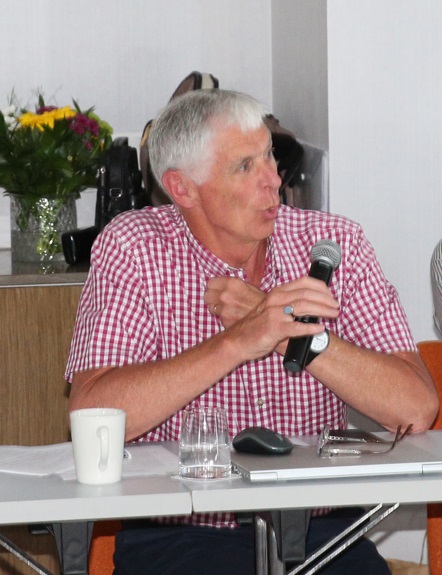
Brian James is a high-profile figure in the European aggregates sector, having formerly held senior roles at both the Aggregates Europe - UEPG and the UK MPA covering the recycling of construction & demolition waste and other secondary sources. He now speaks as an independent voice in support of recycled aggregates and the circular economy. He tells Liam McLoughlin that a number of recent trends and regulatory developments in Europe and the UK could threaten the ability to use recycled aggregates.
If you want to discuss the ongoing potential for the use of recycled aggregates in construction, then Brian James is at the forefront of figures in the European aggregates sector to speak with.
A chartered civil engineer and longstanding member of the UK Institution of Civil Engineers, James worked until recently as special advisor at the UK Mineral Products Association and was also chair of the recycling task force at European aggregates association AE - UEPG.
The European Union has set out a goal for 70% of construction and demolition (C&D) waste to be recycled, and although it is considering increasing this percentage, no formal change has been proposed.
James says that such high targets for recycling of C&D waste, and indeed the ongoing use of recycled aggregates in construction projects across Europe, could be in jeopardy due to a number of recent moves by governments and agencies in the region.
Prominent among these is initial guidance on the use of recycled aggregates brought in by the Republic of Ireland’s Environmental Protection Agency (EPA) in October 2023. The EPA’s guidance – National End-of-Waste Decision EoW-N001/2023 – is available at: https://www.epa.ie/publications/licensing--permitting/waste/Final-Decision---National-End-of-Waste-Criteria-N001-2023.pdf
It covers aggregates that are recycled from C&D waste, including soil and stone, concrete, bricks and ceramics. It is designed to establish criteria determining when recycled aggregate resulting from a recovery operation ceases to be waste.
James says: “The guidance is so heavily restrictive that it as good as dammit killed any hope of developing the country’s recycling industry.
“To put it in perspective in Ireland at the moment, if you had a load of concrete that went out and was not used and sent back to the depot, allowed to go hard, you cannot break it up and use it as general aggregate. The new regulations only allow very limited use, for example to an area 100m by 100m, such as for a car park sub-base, but that’s it - it’s not allowed in structural concrete or any other usage.
“Consequently, you are now getting piles of materials building up around Ireland, mainly in quarries I would imagine. So with this very heavy legislation and an abundance of hard rock, the companies won’t invest in it.”
Circular economy
James says there is a stark contrast between what the Irish guidance is leading to and what the European Commission wants to achieve in pushing up the level of recycling as part of the drive for the Circular Economy.
He adds that the Irish move on aggregates recycling could have a wider impact on subsequent developments in the EU and the UK: “They produce documents, and those can subsequently be picked up by other member states. This happens all the time, and although the UK is outside the EU the influence is still there. At present this problem is particular to Ireland and that the AE - UEPG will help try and resolve, but it’s a tough one.”
Another recently identified trend in Europe is the cross-border trade of construction & demolition waste, with the biggest market thought to be from Germany to the Netherlands due to the latter’s lack of quarries.
“There are moves at the AE - UEPG to instigate an economic study to find out where these cross-border movements are going,” says James. He adds that the cross-border trade development will impact the EU Waste Framework Directive that controls all the regulatory practices around movements of C&D waste.
The practice also raises questions about the increased carbon footprint of C&D waste, which is often recycled at inner city sites with no long-distance transporting of material. With cross-border movements, longer distances are involved at a time when the industry is supposed to be moving to net-zero targets. James was a delegate at the recent Aggregates Europe – UEPG Recycling Task Force meeting in Zurich and says that a recommendation for an initial study of the issue was made.
Another important recent development impacting aggregates recycling is the proposal by the European Union chemicals agency ECHA to change the status of recycled aggregates, which is currently classified as an article to that of substance (which is classified as being of very high concern). The change would be made under the EU REACH regulations which covers risks to human health and the environment from chemicals.
“This would mean that recycled aggregates would have a lot more hoops to jump through before they can be approved for use,” says James. “This would be a backwards step because recycled aggregates have always been classified as an article, and it would mean it is put on the same level as some sort of hazardous material, until you can prove otherwise. If that got off the ground the whole recycled industry is in jeopardy.”
The proposal is due to be decided on at a meeting of the ECHA steering group in May this year. AE - UEPG has already responded on behalf of the European industry with further representation in hand.
A further development, this time in the UK, affecting recycled aggregates is the potential introduction of mandatory digital tracking of all waste products including construction & demolition. The UK government released a discussion paper on this in 2023 with the potential for enactment in April 2025.
“At this stage it is UK-only, but if it expanded to be pan-European this would tie-up with the cross-border aggregates trade issue,” says James.
Commenting on these simultaneous developments – the restrictive aggregates recycling guidance in Ireland, the potential reclassifying of recycled aggregates as hazardous material by the EU’s ECHA agency, the cross-border trade in C&D waste in Europe, and the UK mandatory digital waste tracking proposal – James states: “You can see there are a whole host of potential issues facing aggregates recycling in Europe.”
On a more positive note for the recycling sector, James says he has been involved for several years in working with the European Demolition Association (EDA) to develop the initial demolition protocol. The European Commission is now in the early stages of upgrading the protocol in conjunction with the EDA. “This is just another example of the valuable work done by industry trade bodies,” James adds.
The EDA is also compiling a comprehensive guidance document on the use of recycled materials which is close to publication. “The document is from the demolition perspective, so aggregates are only a part of that. Again AE - UEPG is supporting the EDA.
“It’s currently a comprehensive 30-page document, which unfortunately, tends to get put on the shelf and forgotten. I’ve made the suggestion to the EDA that there needs to be a two- or four-page key messages paper that you can back up with the full reference document.”
Commenting on the importance of the EDA guidance document he continues: “It sets out the process of pre-demo assessment so that hazardous stuff is identified, the various valuable waste/recycle streams recovered (eg. metals/cables etc) before the structure comes down. Hence for aggregates we generally get a cleaner, safer raw material to work with.”

EC recycling target
In 2008, the European Commission’s Waste Framework Directive set a target of having 70% of Construction & Demolition waste in the EU being recycled by 2020. However, the EC found in 2018 that, with the exception of a few EU countries, only about 50% of C&D waste was currently being recycled.
In terms of whether governments and regulators are realistic about targets for the use of recycled materials, he responds: “The answer is no. Across the whole of Europe there are countries like the UK, Belgium, Netherlands, and one or two others, that are hitting around 25-30% levels of recycled aggregates, while there are others where it’s less than 1%.”
As an example of what he believes is typical of the misguided thinking, James highlights a recent EU economic report which suggested that there should be 60% recycled aggregate in all concrete applications.
“We don’t have enough material to meet 10% let alone 60%, it’s just physically not possible,” he adds. “There are people within research groups advising ministers, and all they are doing is jumping on the sustainability bandwagon and have no understanding as to what the industry can actually do. Following representation I understand that this [the EU economic report] has now been withdrawn.”
James says that that there is a failure among authorities to talk to the aggregates industry to find out what it can actually do, and consequently the wrong messages get out.
“One of the serious problems you face with all of this is that the ideas get kicked off in one area and they spread around and they suddenly become the norm – whereas the people in the industry who have to actually make this work have never had a hand in how that decision is made.
“From my time working at the AE - UEPG, you were always trying to play catch-up. We didn’t know what the EU regulators were thinking until they published a draft or a consultation, and then you were trying to argue against it/for reality. You will find a politician will jump on, for example the report that was demanding 60% recycling, and it could be this false golden panacea that undermines any new quarries being given permission.”
Need for more data
The MPA has stated that there is a need for more industry data on recycled aggregates to be made available through official government sources, particularly given the challenges ahead around circularity, sustainability and for all sectors meet the Net Zero target by 2050.
The MPA’s own data is collected mainly from the sources that the association can follow up on, predominantly its membership, and the UK government does not collate any figures about recycled aggregates, either on usage or planning.
The landscape is similar throughout Europe with realistic data being difficult to obtain, and figures are mostly provided through the efforts of the trade associations across the region.

Recycling levels in the EU and Britain
The UK is among the European leaders in the use of recycled primary and secondary aggregates, alongside countries such as the Netherlands and Belgium. Primary aggregates include quarried crushed rock and both land-won and marine dredged sand & gravel, while secondary encompass recycled construction, demolition and excavation wastes (CDEW) or are derived from other industrial, production or extractive processes.
Belgium had the highest percentage share of recycled and secondary materials in total aggregates sales at around 29% in 2021, according to estimates by the MPA and AE - UEPG, with the Netherlands in third position at just over 25%, behind Great Britain. “Unfortunately, there are too many Member States that need to embrace the use of recycled aggregates,” James says.
The amount of recycled aggregates in Great Britain has averaged around 28% of total aggregates produced in recent years. The rate increased to just over 30% in 2022, according to the latest MPA estimates. In 2022 total recycled and secondary sources of aggregates accounted for an estimated 74 million tonnes of total aggregates supply in Great Britain. The MPA estimates that some 191.1 million tonnes of primary aggregates (quarried crushed rock and both quarried and marine-dredged sand & gravel) were produced in the UK in 2022.
Is there much scope to increase the recycling rates in the EU and UK further? “You get fluctuations around that core 28 to 29%, but my personal view is that it’s as good as it’s going to get,” says James.
He says that the availability of materials such as fly ash, for example, for recycling is reducing. “As we get away from fossil fuel power generation, you are losing fly ash because you are not producing any. There are areas where they are digging up old fly ash tips to reprocess it, so it’s a diminishing resource.”
In 2016 fly ash accounted for 1.1 million tonnes of the total 7.8 million of secondary aggregates that were produced in the UK. The MPA figures for 2021 shows UK fly ash production of 388,000 tonnes.
China clay waste is another major secondary aggregate in the UK, with 1.6 million tonnes of China and ball clay waste produced in 2021, according to MPA estimates.
The UK supply of China clay is predominantly in Cornwall in the south west of England. Moving this has previously been limited by the difficulties of transporting it to the rest of the country, but the situation has improved. The supplies from Cornwall are shipped to ports in the south-east of England including Dover, Shoreham and Tilbury. Dover now has an aggregates terminal which recently came on stream.
In terms of the general sources of construction and demolition waste, James says that this is totally dependent on demolition, and its fluctuations are linked to the growth levels of the economy. Demand for aggregates (primary, secondary and recycled) fell in the UK during 2023 because of a fall in demand from the construction sector. The MPA reported in February 2024 there was a 5% decrease in total aggregates sales volumes in 2023. The association says that new construction projects in the pipeline are stalling due to cost pressures, planning challenges and a poor economic and investment backdrop.
“If you’re not building anything you are not, generally speaking, demolishing anything, and that will fluctuate in its own right,” says James.
“If you are trying to make a building more sustainable, and make it more re-useable, then that first line of demolition has been lost instantly. You can see the pattern – if you push it in one direction you lose something in the other, which is nothing new.”
He says, for example, that the HS2 high-speed rail project has recently accounted for most of the available recycled material in the central area of the UK for use in building haul roads and other temporary works, etc. for the scheme, but this was a short-term trend and was not going into the full-blown construction market as part of permanent works. “However, it will reappear at the end of the construction period!” he adds.
Barriers to use
James says that in his opinion, the biggest barrier to the use of recycled aggregates is education and acceptance. “You have a culture where people want the best. In terms of health and safety if you use anything other than the best you are perhaps [seen as] undermining the responsibility of your approach.
“There is always a tendency for engineers and architects to use the best product and material every time. But in truth you have got one set of technical and environmental standards, and if your material complies with those technical standards then it is fit for purpose.”
He says that it can be difficult to convince consulting engineers that a recycled product is going to do the job as well as a primary one.
“You get consultants in certain architectural practices who take these things on board and they want to use it as a part of their credentials,” he states. “But generally you have to get that education and acceptance across that recycled material is an equal product, and that comes from people like us talking about it, making them understand that we are meeting the same technical and environmental standards all the time.”
James says that the leadership on this issue needs to come from government bodies, who are the biggest purchasers of aggregate materials.
He adds that he is not a fan of specifying a set recycled percentage within any contract because that distorts the situation, but says that to have recycled material as a fully accepted alternative source of supply would be useful.
The use of defined amounts of recycled aggregates was reportedly specified in contracts for the London 2012 Olympic Village. “With contracts being frequently prepared on a ‘cut and paste’ basis, then you quite often find that these clauses crop up in other places where you’ve then got to look and see is it appropriate or not,” James says.
He adds that, from what he has gathered anecdotally, the recycled targets in the London Olympics contracts were not met because the quantity of recycled material was simply not available. “It’s that realism of what can be done that is the missing link. There has been a lot of activity in the concrete field for substitution, and in theory you can make concrete in the laboratory out of virtually anything. It’s how it all gets put together, is it going to work in practice and can you deliver it at an economic price?”
He adds that there are additional problems in concrete supply with many concrete plants being in tight urban locations as that is where the concrete is used. “There just isn’t the storage facility for yet another supply [of recycled material for use in concrete] for different jobs,” says James. “In addition to these practical issues there is the thorny old problem of water-to-cement ratio and those sort of arguments. You have to balance what is possible and what is not.
“There are some concrete companies that trade on the term that it is ‘eco mix’. There is research that has shown you can go to around 15% of the coarse aggregate being recycled material and it doesn’t make a vast amount of difference in terms of strength. But you’ve got to have that material available, and it’s got to be of a consistent quality because the whole thing with concrete is that it has got to be consistent and then you know what you’re dealing with.”
Recycled use cases
In terms of the respective use of recycled and secondary aggregates in specific applications, he says: “To look at high-strength concrete as an example, you want to make sure that your aggregates are consistently of the quality required. With recycled material, because your sources are variable, the material is variable.”
He adds that there are plenty of natural aggregates where they are limited to strength of concrete. Oolitic limestone in the UK is a prime example as that is normally limited to a lower strength concrete. “Whereas if you have higher-spec limestones and granites then you can push the strengths right up to the ultimate levels. It’s a very simple approach – use it for what it’s sensible to use it for and don’t over-specify,” James adds.
Regarding the use of secondary aggregates, he says there is a major opportunity to use a secondary aggregate when doing a mass concrete pour for a big foundation where the actual strength requirement is nowhere near as critical as when doing, for example, a slender column. “These are the sorts of the sorts of areas where education is important for acceptance into the right places to use these materials.”
He adds that the majority of recycled aggregates goes into highway construction simply because it’s a great way of using the material efficiently and is an area where it does the job well.
James says most construction companies are realistic about what they can and can’t do with recycled aggregates in terms of their overall supply chain. “If your local ready-mix supplier for a project is not in a position to supply material with a recycled element it doesn’t even come into consideration. Look at your supply chain because they are buying materials in. For example, doing drainage on a motorway where there are slip drains with aggregate on the top. If that is viable the specification allows you to use a secondary material. But is it available locally, is it in supply, can you get it there?"
He says contractors are there to make money and are looking for the most efficient and cost-effective supply materials. “It’s got to be consistent. It’s no good having an order for umpteen hundreds of thousands of tonnes of material if it’s not going to be delivered on time because a day lost on your contract is going to cost you millions.”
Professional achievements
Looking back on his career, Brian James says: “In a sense I’ve had two careers – one in construction and one at the MPA, the trade body for the materials supply-side. I spent the first half of my career using the materials, and the second half supporting and promoting the supply of it.”
In terms of achievements in his initial career of construction, he says that one of the most notable projects early in his professional life came when he was involved in tunnelling and was responsible for the biggest pipe jack that had been laid in the UK at the time. “It was technically a fairly difficult job through the Blackheath beds of sedimentary deposits in south-east London...... like digging through marbles!” Other significant projects have included major highways, bridges and tidal/sea defence works.
In his activities outside the UK he is particularly proud of his work in the mid-1980s on the construction of the King Fahd Causeway, a 25km series of bridges and causeways between Saudi Arabia and Bahrain, on which he was the construction manager responsible for joining the two Gulf states together. “That was one of the biggest projects in the world at the time and I worked on it for about a year, linking all the roads and bridges that linked up to Bahrain. Their version of Spaghetti Junction if you like.”
Outside of his professional life his interests have centred around sport. He previously played junior club level rugby and squash, and now owns a yacht which he sails on the east coast near Ipswich.
Brian James can be contacted at: [email protected]










